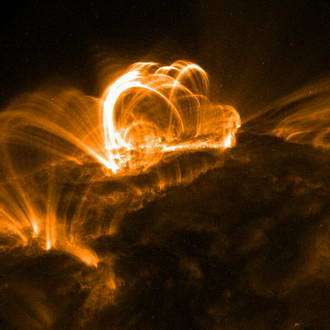Capturing clues to solar mysteries hurtling through space at the speed of light

Solar flare experts from around the world gathered at NJIT last week to share the latest research on the sudden, powerful blasts of electromagnetic radiation and charged particles that burst into space during the Sun's massive eruptions.
The scientists - about 70 in total - all conduct research on data collected by the Reuven Ramaty High Energy Solar Spectroscopic Imager (RHESSI), a space telescope that orbits Earth every 95 minutes, capturing high-energy X-rays and gamma rays produced during solar flares.
What processes unleash solar eruptions with energies equivalent to billions of hydrogen bombs and how particles are rapidly accelerated to nearly the speed of light to produce the detected X-rays and gamma-rays, are fundamental questions scientists have yet to solve.
RHESSI's instruments measure the energy of high energy photons emitted in flares that do not penetrate Earth's atmosphere. It is the only space telescope currently operating that is dedicated to measuring X-rays and gamma rays from the Sun and that can make images of the flaring source region using these electromagnetic radiations.
"To better understand flares, it's important to know what direction their high and low-energy radiations are coming from, when these different energy photons are released in the course of an eruption, and where in the solar environment they are deposited," said Dale Gary, a distinguished professor of physics at NJIT, who uses the RHESSI data to compare with observations from NJIT's recently expanded, solar-dedicated radio telescope, the Expanded Owens Valley Solar Array (EOVSA).
The focus of the workshop is the relationship between solar flare data taken with RHESSI and data for the same flares captured at other wavelengths including the lower-energy radio waves, which provide different views. NJIT was asked to host the gathering following EOVSA's completion this year in order to emphasize the complementary research between radio and hard X-ray studies.
Shaheda Shaik, a Ph.D. student at NJIT who is studying solar physics, has been analyzing flare data captured over four days in March, 2015 by both RHESSI and EOVSA's radio telescope.
"By looking at the data from different wavelengths like radio and X-ray over the electromagnetic spectrum from the Sun, we can determine when, where and how the flare is originated. We can also get many parameters like magnetic field strength, temperature and the density of the flare region on the Sun through these radiations," said Shaik, who presented her findings at the conference.
Optical telescopes such as NJIT's Big Bear Solar Observatory (BBSO) capture high-resolution images of flares in the visible part of the spectrum, providing yet another perspective.
"Unlike an optical solar telescope, which studies radiation associated mainly with much lower-energy phenomena, RHESSI can detect a broad range of the high-energy electromagnetic spectrum," Gary noted. "This gets us closer to the original acceleration processes that power the flare."
The energy released in solar flares, which heats plasma to tens of millions of degrees Fahrenheit, is the equivalent of billions of megatons of TNT. Solar radiation from these eruptions can destroy the electronic systems in satellites used in telecommunications, weather forecasting and navigation systems, among other services. Associated magnetic disturbances can also affect devices on the ground such as transformers.
Brian Dennis, NASA's RHESSI Mission Scientist, said that over the more than 13 years it has been in orbit, RHESSI has provided many unique observations, including data from more than 100,000 X-ray flares and many gamma-ray flares, that have greatly advanced scientific understanding of the phenomena that constitute the most powerful explosions in the solar system.
"Future joint observations with EOVSA promise to provide new and greater insight into these important processes on the Sun," Dennis said.
RHESSI scientists have gathered almost every year since the satellite was launched in 2002. Earlier this summer, NASA extended its mission to its 15th year, to 2017 at least, citing its continuing unique observations and scientific productivity.
Provided by New Jersey Institute of Technology





















